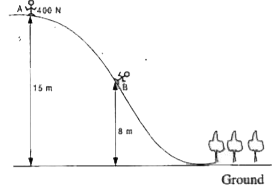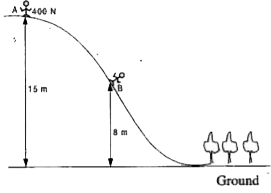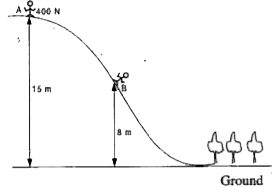Use the figure below to fmd the following

the skier's kinetic energy at B.
6000J−3200J=2800J
Topper's Solved these Questions
- BOOK - S CHAND IIT JEE FOUNDATIONCHAPTER - WORK AND ENERGYEXERCISE - SELF ASSESSMENT SHEET-327videos
WORK AND ENERGY
- BOOK - S CHAND IIT JEE FOUNDATIONCHAPTER - WORK AND ENERGYEXERCISE - SELF ASSESSMENT SHEET-327videos
WORK AND ENERGY
- BOOK - S CHAND IIT JEE FOUNDATIONCHAPTER - MEASUREMENT AND MOTIONEXERCISE - Self Assessment Sheet -1 (a)14videos
MEASUREMENT AND MOTION
Similar Questions
Knowledge Check
- Question 1 - Select One
Which of the following doesn't have kinetic energy?
AFired bulletBRunning waterCWorking hammerDStretched bow - Question 2 - Select One
Which of the following does NOT possess kinetic energy?
AA rolling stoneBA falling coconutCA raised hammerDA speeding car - Question 3 - Select One
Which of the following is used in deriving the kinetic gas equation ?
Amost probable speedBAverage speedCRoot mean square speedDMean square speed
Find the dimensions of the following quantities :
(a) Temperature (b) Kinetic energy
(c) Pressure (d) Angular speedView SolutionA skier is pulled by towrope up frictionless ski slope that makes an angle of 12∘ with the horizontal . The rope moves parallel to the slope with a constant speed of 1.0 m/s. The force of the rope does 880 J of work on the skier as the skier moves a distance of 7.0 m up the incline. (a) If the rope moved with a constant speed of 2.0 m/s, how much work would the force of the rope do on the skier as the skier moved a distance of 8.0 m up the incline ? At what rate is the force of the rope doing work on the skier when the rope moves with a speed of (b) 1.0 m/s and (c) 2.0 m/s ?
View SolutionThe mass of a ball A is double the mass of another ball B. The ball a moves at half the speed of the ball. B. Calculate the ratio of the kinetic energy of A to the kinetic energy of B,
View SolutionWhat is the ratio of the rolling kinetic energy and rotational kinetic energy in the motion of a disc ?
View SolutionA particle is performing linear S.H.M. at a point A, on the path, its potential energy is three times kinetic energy. At another point B on the same path, its kinetic energy is 3 times the potential energy. The ratio of the kinetic energy at A to its kinetic at B is
View Solution



